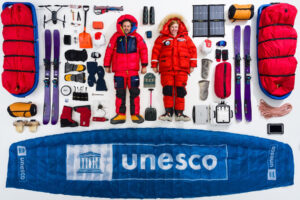Two teams, Science and Traverse operations, were working together to identify and remediate crevasses which had appeared in the past year near McMurdo.
The National Science Foundation (NSF) issued a statement today:
Antarctic Program researcher suffers fatal injury while in the field
Gordon Hamilton, of the University of Maine’s Climate Change Institute, in Orono, a researcher with the NSF-managed U.S. Antarctic Program, suffered a fatal injury on Saturday, Oct. 22, New Zealand time.
Hamilton was killed when the snow machine he was riding went into a crevasse. Hamilton’s team was camped in a heavily crevassed area known as the Shear Zone, approximately 25 miles south of McMurdo Station, the largest of the three U.S. research stations in Antarctica.
NSF manages the Antarctic Program, through which it coordinates all U.S. research on the southernmost continent.
The McMurdo Shear Zone is a three-mile mile wide and more than 125 mile long swath of intensely crevassed ice where the Ross Ice Shelf meets the McMurdo Ice Shelf. The ice is up to 650 feet thick in this area.
Hamilton’s body has been recovered and will be returned to his family in Maine. USAP personnel have begun an accident investigation.
“I am deeply saddened by the news of the tragic death of Dr. Hamilton. Our thoughts are with the family and entire community as we mourn this loss,” said Dr. France Córdova, Director, National Science Foundation.
Hamilton’s research used two robots that contained ground- penetrating radar instruments to study the stability of the Ross and McMurdo ice shelves.
At the time of the accident, the science team was camped approximately 200 yards from the Antarctic Program’s South Pole Operations Traverse crevasse remediation team. The two teams, science and Traverse operations, were working together to identify and remediate crevasses which had appeared in the past year.
The two teams included experienced personnel who had worked in this area over the past several years and all members of both teams had received crevasse and glacial safety training before going into the area. In addition, mountaineers, familiar and experienced with the SZ, were with each of the two teams.
Crevasses had been identified and filled earlier in the week and work on a newly identified crevasse was beginning at the time of the accident.
Gordon Hamilton joined the university’s Climate Change Institute in 2000 as an assistant research professor. Prior to coming to Maine, he was at the Byrd Polar Research Center at Ohio State University and the Norwegian Polar Institute in Olso.
He studied the behavior of modern ice sheets and their role in the climate system. His research focused on understanding ice sheet mass balance — how much mass is coming in and going out, and the processes responsible — and involved satellite remote sensing. His current research projects included ice-ocean interaction in Greenland and ice shelf stability in Antarctica.
He also taught undergraduate and graduate courses at the university, and was involved in statewide STEM initiatives for grades 9-12.
Read more about Hamilton here.
Previous on Explorersweb/Pythom
South Pole skier, Henry Worsley, passed away (January 24, 2016)
#polar #antarctica #southpole #thepoles #fatalaccident





